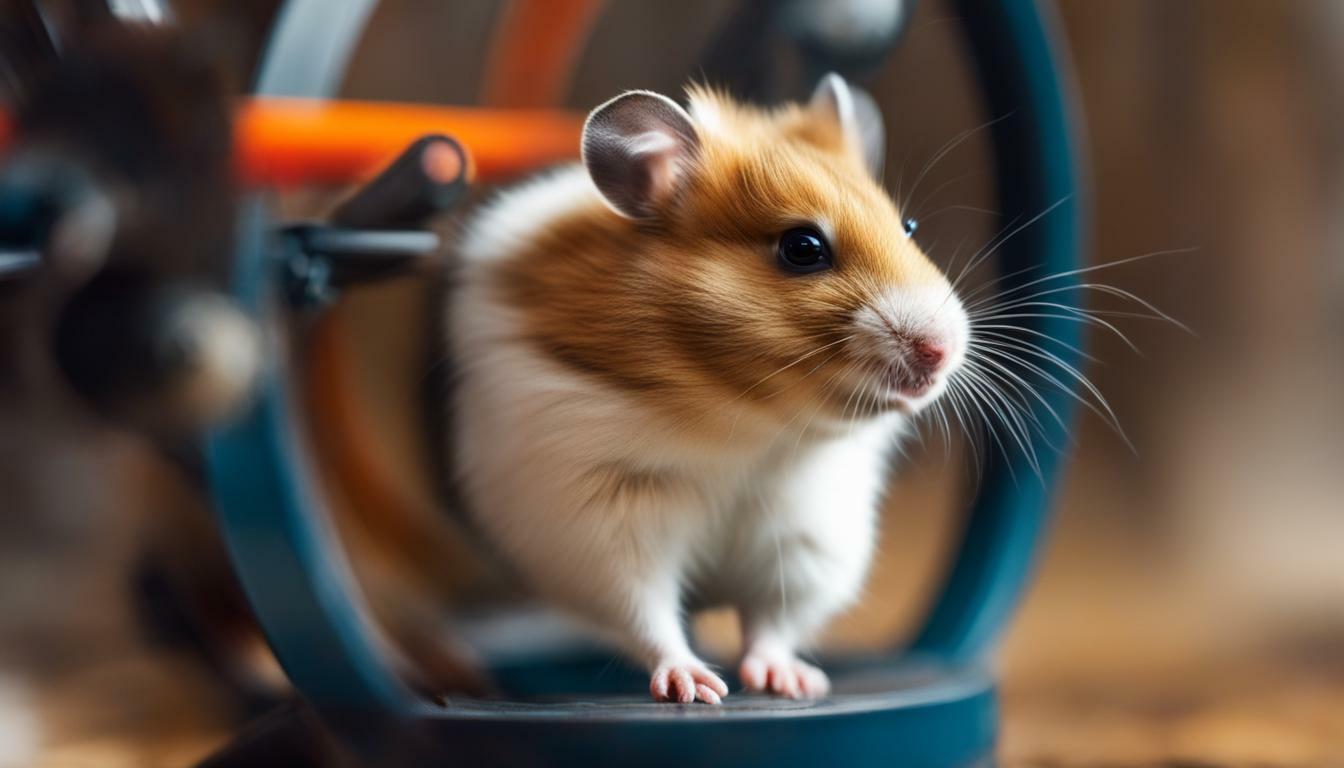Hamsters are known for their love of running on exercise wheels, but have you ever wondered how long they actually spend on their wheels? In this section, we will explore the duration of hamsters running on their wheels and provide information on how long they typically spend exercising on a wheel each day.
Key Takeaways:
- Hamsters can run on their wheels for 4 to 6 hours every night.
- Dwarf hamsters tend to run for less time than Syrian hamsters.
- Running on a wheel provides exercise for hamsters and helps them stay healthy and happy.
- Letting a hamster run on its wheel all day can lead to weight gain and health issues.
- Choosing the right size wheel for the hamster’s body size is important.
Hamster Wheel Running Habits
Hamsters have individual running habits, but on average, they run on their wheels for a specific number of hours each day. This exercise is vital for their physical and mental well-being. Hamsters are naturally active creatures, and running on a wheel is an instinctual behavior that allows them to burn off energy and stay fit.
According to research, the average hamster spends around 4 to 6 hours running on their wheel every night. Dwarf hamsters typically run for slightly shorter durations compared to Syrian hamsters, but both enjoy the activity. The duration of wheel running can vary depending on factors such as the hamster’s age, breed, and overall energy levels. Some hamsters may run for longer periods, while others may be content with shorter sessions. It’s important to observe your hamster’s behavior and adjust their exercise routine accordingly.
While hamsters may have individual preferences when it comes to their running habits, it’s crucial to provide them with regular exercise opportunities. Running on a wheel not only helps them stay physically fit but also provides mental stimulation that prevents boredom. To ensure your hamster’s well-being, it’s important to strike a balance between exercise and other essential activities like eating, drinking, and resting.
| Hamster Type | Average Running Time (hours) |
|---|---|
| Dwarf Hamsters | Approximately 3 to 4 hours |
| Syrian Hamsters | Approximately 4 to 6 hours |
While it can be tempting to let your hamster run on its wheel all day, excessive exercise can have negative consequences. Overexertion can lead to weight gain and health issues. To prevent this, it’s important to choose the right size wheel for your hamster’s body size. A wheel that is too small can cause discomfort and limit their exercise potential, while a wheel that is too large may pose a risk of injury. Additionally, make sure the running surface is safe and doesn’t cause footpad injuries.
Monitoring your hamster’s behavior is essential. If you notice your hamster spending excessive time on the wheel without eating or drinking, it may be necessary to regulate their behavior. Consider removing the wheel for short periods to ensure they engage in other activities and maintain a balanced routine.
Choosing the Right Size Wheel
The size of the exercise wheel plays a crucial role in determining how long a hamster can comfortably run and exercise on it. It’s important to choose a wheel that is appropriate for your hamster’s body size to ensure their safety and well-being.
For dwarf hamsters, a smaller wheel with a diameter of around 6 to 8 inches is suitable. These smaller hamsters have shorter legs and may find larger wheels difficult to use. On the other hand, Syrian hamsters, which are larger in size, require a wheel with a diameter of at least 8 to 10 inches to accommodate their longer bodies and legs.
Providing the right size wheel is essential to prevent any discomfort or injury to your hamster. If the wheel is too small, it can cause the hamster’s back to arch unnaturally, leading to potential spinal problems. Likewise, if the wheel is too large, the hamster may struggle to run properly, which can also result in injury.
| Hamster Type | Wheel Diameter (inches) |
|---|---|
| Dwarf Hamsters | 6 to 8 |
| Syrian Hamsters | 8 to 10 |
Remember, the goal is to provide your hamster with a comfortable and safe exercise experience. By selecting the appropriate wheel size, you can ensure they have a fulfilling workout session while minimizing the risk of any potential health issues.
Health Considerations
While running on a wheel is beneficial for hamsters, there are health considerations to keep in mind to ensure their overall well-being. Hamsters are naturally active animals and enjoy spending time on their wheels, but excessive wheel usage can lead to weight gain and potential health issues. It’s important to find a balance between exercise and other necessary activities such as eating, drinking, and resting.
To prevent weight gain and maintain a healthy weight, it’s recommended to limit a hamster’s wheel spinning time to about 4 to 6 hours every night. This allows them to get the exercise they need without neglecting their other needs. Dwarf hamsters generally run for shorter durations compared to Syrian hamsters, so it’s important to observe their behavior and adjust the exercise routine accordingly.
In addition to monitoring their wheel running time, it’s crucial to provide a safe running surface for hamsters. Choose a wheel with a suitable size that allows their body to move comfortably without straining or causing injury. A wheel that is too small can lead to footpad injuries, while a wheel that is too large may cause discomfort or imbalance. Regularly check the wheel for any wear and tear, and ensure it spins smoothly without any sharp edges or loose parts.
If you notice that your hamster is spending excessive time on the wheel without taking breaks for eating or drinking, it may be necessary to regulate their behavior. Hamsters may become so engrossed in running that they neglect their other essential activities. Removing the wheel for short periods throughout the day can help establish a more balanced routine and ensure your hamster’s overall well-being.
| Health Considerations for Hamster Wheel Usage | |
|---|---|
| Find a balance between wheel exercise and other activities. | 4 to 6 hours of wheel running time per night is recommended. |
| Observe your hamster to determine the appropriate exercise routine. | Dwarf hamsters may run for shorter durations than Syrian hamsters. |
| Choose a wheel size that suits your hamster’s body and prevents footpad injuries. | Regularly inspect the wheel for any damage or discomfort. |
| Remove the wheel periodically to encourage eating, drinking, and resting. | Regulate behavior to ensure overall well-being. |
Preventing Boredom
Running on a wheel not only provides physical exercise for hamsters but also keeps them mentally stimulated, preventing boredom. Hamsters are naturally active creatures and running on a wheel allows them to release their energy in a controlled environment. It is important to encourage their natural instincts and provide opportunities for exercise to promote their overall well-being.
When choosing a hamster wheel, consider the size and breed of your hamster. Syrian hamsters are larger and may require a larger wheel compared to dwarf hamsters. The wheel should be spacious enough to accommodate their running habits comfortably. A wheel that is too small can restrict their movement and may lead to injuries. On the other hand, a wheel that is too large may be difficult for them to use effectively.
To prevent footpad injuries, ensure that the wheel’s surface is safe and comfortable for your hamster. Opt for a solid surface or a solid running track instead of wire or mesh wheels which can cause harm. Regularly clean the wheel to prevent the buildup of dirt, feces, or bedding that can be abrasive to their delicate paws.
Hamster Wheel Exercise Duration:
When it comes to hamster wheel exercise duration, it’s important to find the right balance. Hamsters have their individual preferences and stamina levels, so observe their behavior and adjust accordingly. Pay attention to signs of fatigue, excessive running, or neglecting other essential activities like eating, drinking, and resting.
| Hamster Breed | Average Wheel Running Duration |
|---|---|
| Syrian Hamsters | 4-6 hours per night |
| Dwarf Hamsters | 2-4 hours per night |
As responsible pet owners, it’s our role to provide a balanced routine for our hamsters. Encourage them to exercise on the wheel during the evening or night, simulating their natural activity patterns. If you notice that your hamster is spending an excessive amount of time on the wheel without eating or drinking, it may be necessary to regulate their behavior by temporarily removing the wheel for short periods of time.
By promoting an active exercise routine while ensuring their overall well-being, you can keep your hamster happy, healthy, and entertained.
Footpad Injury Prevention
To ensure the well-being of your hamster’s feet, it’s crucial to choose a wheel with a safe surface and monitor their exercise duration. Hamsters love running on their wheels, but constant spinning can lead to footpad injuries if the surface is too rough or abrasive.
When selecting a hamster wheel, opt for one with a solid, smooth surface that won’t cause discomfort or damage to your furry friend’s delicate feet. Avoid wheels with wire or mesh surfaces, as these can potentially trap their tiny paws and cause injury. Instead, choose a wheel made of solid plastic or wood, which provides a safe and comfortable running experience.
Additionally, it’s important to monitor your hamster’s exercise duration on the wheel. While running is beneficial for their physical and mental health, excessive wheel time can put strain on their feet. Aim for a moderate exercise duration of 1 to 2 hours per day, allowing your hamster to rest, eat, and drink in between exercise sessions.
| Tip: | Place a soft bedding material, such as shredded paper or wood shavings, in the bottom of the wheel to create a cushioned surface for your hamster’s feet. This will help reduce the impact and prevent footpad injuries. |
|---|
By choosing a wheel with a safe surface and monitoring their exercise duration, you can ensure that your hamster stays active and healthy without risking footpad injuries. Remember to provide ample opportunities for rest and always prioritize your hamster’s well-being.
Monitoring Hamster Behavior
While hamsters enjoy running on their wheels, it’s essential to monitor their behavior and ensure they have enough time for other essential activities. Running on a wheel provides exercise for hamsters and keeps them healthy and happy, but it’s important to strike a balance. Hamsters typically run on their wheels for 4 to 6 hours every night, but they also need time for eating, drinking, and resting.
To monitor your hamster’s behavior, pay attention to how much time they spend on the wheel versus engaging in other activities. If you notice that your hamster is spending excessive time on the wheel without eating or drinking, it may be necessary to regulate their behavior. One way to do this is by temporarily removing the wheel for certain periods of time to ensure they focus on other essential activities. This will help prevent them from becoming overly fixated on running on the wheel and neglecting their basic needs.
Observing your hamster’s behavior is crucial in ensuring their overall well-being. A healthy hamster will engage in a variety of activities throughout their day, including running on the wheel, exploring their habitat, socializing with their cage mates (if applicable), and taking time to rest. If you notice any significant changes in their behavior, such as a sudden decrease in wheel usage or loss of appetite, it’s important to consult a veterinarian, as these could be signs of underlying health issues.
| Activity | Duration |
|---|---|
| Running on the Wheel | 4-6 hours per night |
| Eating and Drinking | Multiple times throughout the day |
| Exploring and Socializing | Varies depending on the hamster |
| Resting | Several hours per day |
In conclusion, while running on a wheel is a natural and enjoyable activity for hamsters, it’s crucial to monitor their behavior and ensure they have enough time for other essential activities. By maintaining a balanced routine, you can help your hamster stay happy, healthy, and stimulated.
Regulating Behavior
If a hamster spends excessive time on the wheel without eating or drinking, it may be necessary to regulate their behavior by temporarily removing the wheel. While running on the wheel provides essential exercise for hamsters and helps them stay healthy and happy, it’s crucial to ensure they maintain a balanced routine that includes sufficient time for eating, drinking, and resting.
Hamsters have a natural inclination to run on their wheels, but it’s important to monitor their behavior and make adjustments as needed. If you notice that your hamster is spending an excessive amount of time running on the wheel to the point where it neglects its other essential activities, it’s a sign that intervention may be necessary. By temporarily removing the wheel for short periods, you can regulate their behavior and encourage them to engage in other necessary tasks.
Remember, a hamster’s well-being relies on more than just running on a wheel. By providing a balanced routine that includes regular access to food, water, and rest, you can ensure your hamster maintains a healthy lifestyle. Moderation is key when it comes to exercise, and by observing your hamster’s behavior and adjusting the wheel usage as needed, you can promote their overall physical and mental well-being.
| Key Points: |
|---|
| If a hamster spends excessive time on the wheel without eating or drinking, it may be necessary to regulate their behavior by temporarily removing the wheel. |
| Running on a wheel provides exercise for hamsters, but they also need time for essential activities like eating, drinking, and resting. |
| Monitor your hamster’s behavior and adjust wheel usage if they are neglecting important tasks. |
| By providing a balanced routine, you can ensure your hamster maintains a healthy and happy lifestyle. |
Dwarf Hamsters vs. Syrian Hamsters
The duration of time that hamsters spend on their wheels can vary depending on their species, with dwarf hamsters typically running for a shorter period compared to Syrian hamsters. Factual data shows that hamsters can run on their wheels for 4 to 6 hours every night, engaging in this exercise to stay healthy and happy while avoiding boredom. However, it’s important to ensure that hamsters don’t spend excessive amounts of time on their wheels as this can lead to weight gain and potential health issues.
Choosing the right size wheel for your hamster’s body size is essential. For dwarf hamsters, a smaller wheel is recommended, while larger Syrian hamsters need a bigger wheel to accommodate their size. Providing a safe running surface on the wheel is crucial to prevent footpad injuries, as hamsters’ feet are sensitive. Make sure the wheel is smooth, with no sharp edges or gaps that could cause harm.
While hamsters naturally enjoy running on their wheels, it’s important to ensure they are also getting enough rest, food, and water. If you notice that your hamster is spending too much time on the wheel without engaging in necessary activities like eating or drinking, it may be necessary to regulate their behavior. You can temporarily remove the wheel for certain periods to encourage them to take breaks and establish a more balanced routine.
In summary, the duration of time that hamsters spend on their wheels can vary depending on the species, with dwarf hamsters running for shorter periods compared to Syrian hamsters. Running on a wheel provides exercise, mental stimulation, and prevents boredom for hamsters. However, it’s important to strike a balance and ensure they are taking breaks for necessary activities like eating, drinking, and resting. By providing the right size wheel and a safe running surface, you can help your hamster maintain a healthy exercise routine while keeping their overall well-being in mind.
| Species | Wheel Running Duration |
|---|---|
| Dwarf Hamsters | 3 to 4 hours |
| Syrian Hamsters | 4 to 6 hours |
Conclusion
Understanding how long hamsters typically run on their wheels is crucial for ensuring their physical and mental well-being, but it’s equally important to maintain a balance in their exercise routine.
On average, hamsters can run on their wheels for 4 to 6 hours every night, with dwarf hamsters running for slightly less time than Syrian hamsters. This activity provides essential exercise, keeping them healthy and happy while preventing boredom. However, allowing a hamster to run on its wheel all day can lead to weight gain and potential health issues.
Choosing the right size wheel for your hamster’s body size is essential. This ensures they have enough space to exercise comfortably. Additionally, providing a safe running surface is important to prevent footpad injuries, which can occur if the wheel is too rough or doesn’t have appropriate traction.
While hamsters naturally enjoy running on their wheels, it’s crucial to ensure they also prioritize other important activities like eating, drinking, and resting. If you notice that your hamster is spending excessive time on the wheel without attending to these needs, it may be necessary to regulate their behavior by temporarily removing the wheel for short periods.
In conclusion, maintaining a balanced exercise routine for your hamster is key to their overall health and well-being. Understanding their typical running habits, providing a suitable wheel, and monitoring their behavior will help ensure that they receive the right amount of exercise without neglecting their other essential needs.
FAQ
How long do hamsters run on their wheel?
Hamsters can run on their wheels for 4 to 6 hours every night, with dwarf hamsters running for less time than Syrian hamsters.
Why is running on a wheel important for hamsters?
Running on a wheel provides exercise for hamsters, helps them stay healthy and happy, and prevents boredom.
Can a hamster run on its wheel all day?
It’s not recommended to let a hamster run on its wheel all day, as this can lead to weight gain and health issues.
How do I choose the right size wheel for my hamster?
It’s important to choose a wheel that is appropriate for your hamster’s body size to ensure they can comfortably use it for exercise.
How can I prevent footpad injuries while my hamster is running on the wheel?
Ensure the wheel provides a safe surface for your hamster, and regularly check for any signs of footpad injuries.
What should I do if my hamster spends too much time on the wheel without eating or drinking?
If your hamster is neglecting important activities like eating or drinking due to excessive wheel usage, it may be necessary to take the wheel away for periods of time to regulate their behavior.




